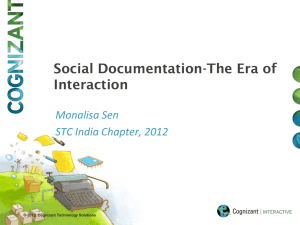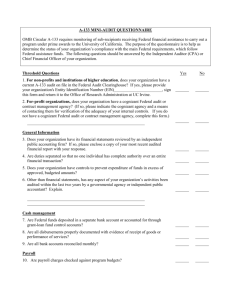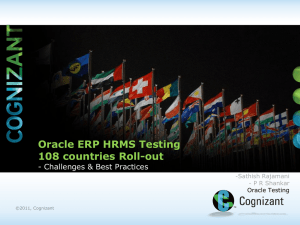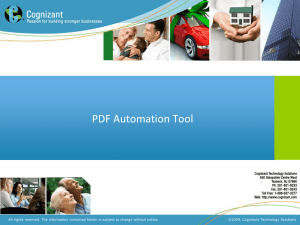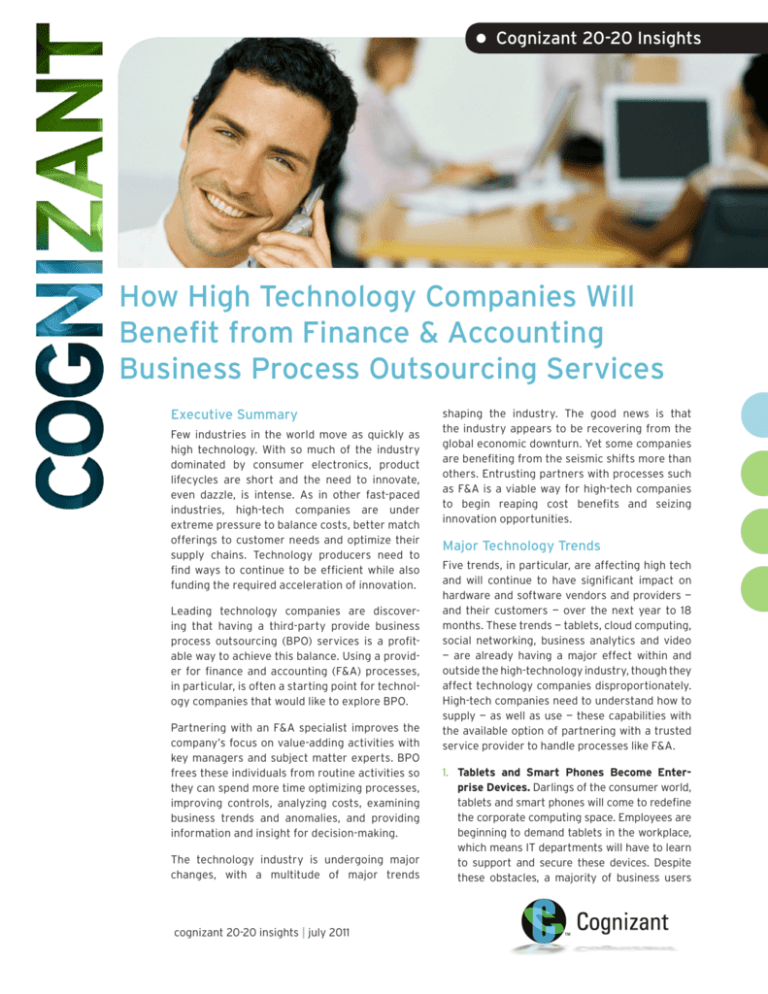
• Cognizant 20-20 Insights
How High Technology Companies Will
Benefit from Finance & Accounting
Business Process Outsourcing Services
Executive Summary
Few industries in the world move as quickly as
high technology. With so much of the industry
dominated by consumer electronics, product
lifecycles are short and the need to innovate,
even dazzle, is intense. As in other fast-paced
industries, high-tech companies are under
extreme pressure to balance costs, better match
offerings to customer needs and optimize their
supply chains. Technology producers need to
find ways to continue to be efficient while also
funding the required acceleration of innovation.
Leading technology companies are discovering that having a third-party provide business
process outsourcing (BPO) services is a profitable way to achieve this balance. Using a provider for finance and accounting (F&A) processes,
in particular, is often a starting point for technology companies that would like to explore BPO.
Partnering with an F&A specialist improves the
company’s focus on value-adding activities with
key managers and subject matter experts. BPO
frees these individuals from routine activities so
they can spend more time optimizing processes,
improving controls, analyzing costs, examining
business trends and anomalies, and providing
information and insight for decision-making.
The technology industry is undergoing major
changes, with a multitude of major trends
cognizant 20-20 insights | july 2011
shaping the industry. The good news is that
the industry appears to be recovering from the
global economic downturn. Yet some companies
are benefiting from the seismic shifts more than
others. Entrusting partners with processes such
as F&A is a viable way for high-tech companies
to begin reaping cost benefits and seizing
innovation opportunities.
Major Technology Trends
Five trends, in particular, are affecting high tech
and will continue to have significant impact on
hardware and software vendors and providers —
and their customers — over the next year to 18
months. These trends — tablets, cloud computing,
social networking, business analytics and video
— are already having a major effect within and
outside the high-technology industry, though they
affect technology companies disproportionately.
High-tech companies need to understand how to
supply — as well as use — these capabilities with
the available option of partnering with a trusted
service provider to handle processes like F&A.
1. Tablets and Smart Phones Become Enterprise Devices. Darlings of the consumer world,
tablets and smart phones will come to redefine
the corporate computing space. Employees are
beginning to demand tablets in the workplace,
which means IT departments will have to learn
to support and secure these devices. Despite
these obstacles, a majority of business users
Beyond Transactional BPO
Technology companies are beginning to seek
partners not only for transactional processes
like invoice processing, but are moving to
higher value processes as well. For example,
we are currently working with an online
advertising provider to perform analytics
and non-routine reporting. Sourcing these
processes from a third-party specialist not
only helped the online advertising provider
to reduce costs but also reduced its time to
market, which in turn helped this company
serve its clients more quickly and efficiently.
Moreover, this company has also been able
to make the new analytics available to its
external clients, thereby gaining a new valueadded marketplace offering.
High-tech companies are also partnering with
third-party specialists on financial process
redesign. We recently helped a prominent
online search company assess and reengineer
its F&A processes, including process mapping,
value mapping and process analysis. We helped
the client globalize, standardize and optimize
processes to improve both efficiency and effectiveness. The team identified potential savings
of over $20 million per year.
Companies that partner with an F&A specialist
find that they gain both capacity and improved
focus on value-adding activities with their
retained personnel (typically, key managers
and subject matter experts). BPO frees these
individuals from the day-to-day grind so they
can spend more time understanding how to
improve processes, improve controls, analyze
costs, analyze business trends and anomalies,
and provide information and insight.
Seizing the Innovation Opportunity
The technology industry is at an inflection
point, with a multitude of major trends
reshaping the landscape. Recent data show
that the trends are measurable, real and significant. The good news is that analysis of the
industry’s financial performance indicates
recovery from the Great Recession. Yet
clearly some industry players are benefiting
from the seismic shifts, while others are
lagging. Entrusting partners with processes
such as F&A is a viable way for high-tech
companies to begin reaping cost benefits and
seizing innovation opportunities, enabling
them to seize the high ground afforded by
rapid changes in technology that are forever
altering the way all companies do business.
will have them in short order. In 2011 alone,
over 12.5 million — 25% — tablets worldwide
will be bought by enterprises, according to estimates from Deloitte.1 The rise of tablets and
smart phones as corporate computing devices
is putting pressure on IT departments, as well
as software security providers. According to
numerous published reports, over 50% of computing devices sold globally in 2011 will not be
PCs. Over 1.39 billion mobile phones were sold
in 2010 and the smartphone market is growing
at over 43%.2 The rising popularity of featurerich smartphones that are capable of mobile
commerce presents a major opportunity for
companies that provide security technology and services as more corporate data and
systems access moves to mobile devices.
computing will be the norm, according to
our research.3 Over 70% of the enterprises
worldwide will have adopted cloud-based IT
services in some capacity. To date, financial
services companies have been the early
movers with over 50% having adopted some
form of cloud already.4 In three years, cloud
adoptions will spread across geographies.
Western Europe is forecast to be the second
biggest market after the U.S., according to
published reports.5
For technology companies, the move towards
a cloud-enabled world means significant
changes. One, there is an urgent need to
generate cash and funding, to enable the
organizational infrastructure to move onto
the cloud. The second, more important, piece
in many cases is to deliver the company’s
product or service via the cloud. For many
companies, this is an imperative, not a choice.
The third driver for adoption is to keep up with
the business ecosystem. As more and more
partners (customers, suppliers, competitors)
2. Cloud Dominates the Delivery of IT Infrastructure and Services. Cloud is a game
changer. It has already changed the way
companies consume IT infrastructure, applications and business processes, and its influence
will continue and accelerate. By 2014, cloud
cognizant 20-20 insights
2
move onto the cloud model, companies will
lose the choice to adopt or not to adopt cloud
— rather, it becomes a question of how soon.
3. Social Network Use by Business Will Evolve
and Grow. Social networks will continue to
rise in their sphere of influence and persuasion. Indeed, social platforms are expected to
grow by 33% in 2011.6 The next step, social networking analytics, will help businesses better
understand consumer trends and employee
behavior. Enterprises will start integrating
social networking with business applications
as part of a coordinated strategy. They will also
reinvent their online customer communities to
reflect new social media capabilities. Companies will use these platforms to engage with
prospects, customers and interested parties to
better understand their needs. Companies will
increasingly use e-communities as a platform
for co-creation and co-invention with their
best customers. E-communities will also serve
as a platform for employee collaboration as
company systems become further integrated
with social networking capabilities. This evolution will provide a great opportunity for companies offering both business-to-business and
business-to-consumer collaboration solutions.
4. Real-Time Predictive Analysis Will Drive
Business Results. This is a most exciting time
as far as analytics and data-driven decision
making are concerned. Never in the history
of human existence has so much data been
generated. According to IDC, the amount of
data already exceeds the amount of storage.
This fact comes with its own opportunities
and unique challenges. Decision-making is
fast moving from decisions based on samples
of data (how things happened in the past) to
decisions based on real-time information (as
things are happening today). Businesses will
increasingly leverage analytics and social
networking to make better-informed decisions,
in the moment.
Technology companies are in a pole position
with regard to real-time data availability.
The future of business analytics will turn on
companies’ abilities to simulate scenarios and
forecast results using live data, giving rise
to the ability to act much more quickly and
proactively than before. The digital nature
of the high-tech industry gives it access to
immense amounts of data. Those companies
that pioneer ways to incorporate that data
into real-time actionable information will have
huge competitive advantages.
cognizant 20-20 insights
5. Video Comes to the Fore. A number of forces
are driving video to the fore: everything from
digital photography, consumer electronics, social networks, mobile computing and
tablets to Internet-based television, interactive customer support and interactive field
service. Video, in fact, is taking a front seat
for businesses to deliver product details, to
showcase executives, and to explain their
services. Video will become a key component
of corporate communication, both internal and
external, allowing companies to cut corporate
travel budgets, and the opportunity is huge for
players in this space.
Economic Agenda: Growth
According to our research and analysis, growth
in global technology spending has already
reached pre-recession levels of 5% (see Figure
1). Technology companies’ first-quarter 2011
results have surpassed market expectations
comfortably. The combined revenues of the
top technology companies show 11% growth in
2010, compared to -0.4% in 2009.7 For full-year
2011 these companies are expected to grow
at 13%. 8 Innovators with clear competitive
advantage are the ones driving growth, rather
than the traditional industry heavyweights
(see Figure 2).
Coming out of the recession, companies that
are leaders and innovators are focusing more
on top- and bottom-line growth, while spending
on sales, general and administrative (SG&A)
remains lean (see Figure 3). Apple, Google and
Intel have performed exceedingly well on net
profit margins, due in part to their ability to
manage SG&A expense. The implications are
obvious: Technology firms need to find ways
to continue to manage costs and fund the
required acceleration of innovation. They need
to generate cash to fund R&D and innovation,
maximize value extraction from new product
development, and ensure product development
speed and efficacy.
As major technology and economic shift continues to unfold, high-tech companies face several
strategic opportunities. To insulate against
future downturns, they must create flexible
business models. They can shield themselves
from talent shortages by accessing highquality talent and capabilities offshore. These
activities will in turn help them cut time to
market and increase productivity as well as
reduce costs.
3
Economic Growth Returns
Global technology spend growth has already reached pre-recession levels of 5%.
The Q1 2011 results of tech companies have surpassed market expectations comfortably.
The combined revenues of the top tech companies show 11% growth in 2010 compared
to -0.4% in 2009. In 2011, these companies are expected to grow at 13%.
Industry Revenue ($bn)
Revenue Growth
800
700
600
500
400
300
200
100
0
2011E
Hardware Industry 16%
Software Industry 8%
Internet Industry 13%
Overall Technology
Industry
Hardware Industry
2010
Hardware Industry 12%
Software Industry 6%
Internet Industry 17%
Software Industry
2009
Hardware Industry 0.3%
Software Industry -5%
Internet Industry 11%
E*
10
20
11
20
09
20
08
20
07
20
06
20
20
05
Internet Services
Industry
Combined revenues of the top companies from each industry segment include:
Hardware – HP, Dell, Apple, Cisco & Intel.
Software – Microsoft, IBM, SAP, Oracle & Symantec.
Internet Services – Amazon, Google, eBay & Yahoo.
* UBS analyst reports
Source: Company annual reports and 10-K filings
Figure 1
Segmenting Tech Industry Growth
35%
Early adopters with clear business strategy are the ones
driving growth; not the industry heavyweights.
Contenders
25%
20%
Yahoo $6bn eBay $9bn
Laggards
15%
Intel
Oracle $44bn
$27bn
Cisco
$40bn
IBM
$100bn
Symantec $6bn
10%
5%
Google
$29bn
Microsoft
$62bn
Amazon
$34bn
Slow movers
0%
-20%
-10%
0%
Apple
$65bn
SAP $17bn
HP
$126bn
Dell
$53bn
Net Profit Margin 2010
Net Profit Margin 2010
30%
Leaders/
Innovators
10%
Spoilers
20%
30%
40%
Revenue Growth 2010
Source: Company annual reports and 10-K filings
Figure 2
New Platforms for Innovation
and Growth
The technology industry is leveraging all forms
of services delivery at an accelerating rate to
respond to these imperatives (see Figure 4). Ten
years ago, the technology industry entered into
roughly 20 new global services deals per year
according to our research. Five years ago, the
technology industry entered into approximately
cognizant 20-20 insights
30 new deals each year. Today, the technology
industry enters into 50-some new deals per
year.9
As in other industries, most high-tech companies
used IT as their entrée into global service
delivery. Today, however, the technology industry
is increasingly adopting BPO for functions
such as finance and accounting (F&A), human
resources and customer support. In addition to
4
Revenue & Profit Increases; SG&A Remains Lean
Apple, Google and Intel have performed exceedingly well on net profit margins; due in
part by managing SG&A expense.
SG&A as % of Revenue
Net profit Margin
30%
50%
40%
30%
20%
10%
0
2010
2009
20%
0%
Microsoft
Google
Intel
Oracle
Apple
eBay
Yahoo
Cisco
IBM
SAP
Symantec*
HP
Amazon
Dell
10%
2010
2009
Apple
HP
Dell
Intel
Google
Amazon
IBM
Oracle
SAP
Cisco
Microsoft
Yahoo
eBay
Symantec
40%
Peer group average (2010)
*Symantec – Goodwill impairment charges have been discounted from 2009 profit
Source: Company annual reports and 10-K filings
Figure 3
Dependence on Global Services Accelerates
In ten years the technology industry has approximately tripled the number of new
sourcing deals entered per year
2011E – 59 Deals
2010 – 47 Deals
10 years ago the tech industry entered into
twenty-some new sourcing deals per year
2009 – 57 Deals
5 years ago the tech industry entered into
thirty-some new sourcing deals per year
2008 – 50 Deals
2007 – 42 Deals
Today the tech industry enters into
fifty-some new sourcing deals per year
2006 – 44 Deals
2005 – 37 Deals
2004 – 34 Deals
2002 – 28 Deals
Cisco, Dell, Google, HP, Microsoft, Novell, Symantec, Yahoo
Dell, EMC, HP, Microsoft, Sun Microsystems, Yahoo
Apple, HP, Microsoft, NEC, Unisys Corp, IBM, Dell, Novell
AOL, Apple, EDS, HP, Microsoft,SAP America Inc, Sun Microsystems
Avaya, EDS, Fujitsu, HP, Microsoft,Sun Microsystems, IBM
2003 – 30 Deals
2001 – 21 Deals
Citrix, EMC, Google, Intel, Lenovo, Microsoft
Dell, HP, Intel, Microsoft, Novell, SAP, Symantec
Avaya, EMC, Gateway, HP, Microsoft,Novell, Unisys Corp, Yahoo, IBM
Apple , Borland, EMC, HP,i2, IBM, Microsoft, Oracle
AOL, CSC, EDS, Getronics, Apple, HP, Intel, Logitech, Microsoft
Note: The list is not intended to be exhaustive but illustrative to show trends
Source: Cognizant research and analysis
Figure 4
having built offshore software development and
maintenance capabilities, technology companies
are buying specialized capabilities such as
F&A and HR from third parties. While accounts
payable (AP), accounts receivable (AR), fixed
asset accounting (FA) and general ledger (GL)
constitute the majority of F&A outsourcing (FAO)
services, companies have started sourcing tax,
regulatory reporting, internal audit and other
complex activities from third parties.
This trend is gaining momentum outside of the
technology sector as well. BPO and FAO are
growing rapidly across all industries. In 2011,
cross-industry BPO is expected to grow at over
30% and FAO at over 20%,10 according to the
Everest Research Institute. The total contract
value of new FAO deals is estimated to reach
cognizant 20-20 insights
more than $4.5 billion in 2011, according to
Everest.11
Globalization of technology companies’ operating models through these partnerships is an
accelerating and measurable response to the
current technology and economic trends. Technology companies are discovering that BPO
in general, and F&A services in particular, can
be their pathway to creating an agile business
model that promotes growth and innovation
while reducing costs.
Most companies begin their F&A services journey
with transaction-processing work such as
accounts payable, accounts receivable, general
accounting, fixed asset accounting and payroll.
As they get more comfortable, they expand
5
into financial reporting, analytics, compliance
activities and treasury work.
• Automate record-to-report (R2R). Here, the
goal is to automate the R2R processes that
do not add value, such as manual journal processing and reconciliations. We use automated
tools, period-end close management tools, and
well-defined procedures, to minimize manual
processing and improve process predictability
and visibility.
We have taken a unique approach to the three
major aspects of F&A:
• Commoditize
procure-to-pay (P2P). P2P
processes (including purchasing, accounts
payable and travel & enterTechnology companies tainment) are typically highly
are discovering that manual, with few controls and
end-to-end process view.
BPO in general, no
We use state-of-the-art tools
and F&A services in with a goal of eliminating all
particular, can be their manual P2P work.
pathway to creating
an agile business
model that promotes
growth and innovation
while reducing costs.
• “Verticalize” order to cash
(O2C). These processes (including order management,
invoicing, dispute management,
collections and AR) tend to
have industry-specific requirements and characteristics
and are therefore best optimized using industry-specific best practices. We have industry
domain knowledge and expertise to provide
industry-tailored O2C solutions.
Looking Ahead
Partnering with an F&A specialist brings an
immediate cost advantage and capability
improvement. This results from economies of
scale gained by processing greater volumes
than any individual company and core skill sets
that includes a higher mix of experienced and
degreed personnel. The provider also does this
work in a lower cost location, supported by a
larger investment in best practice research
and technology. FAO also improves controls
by providing improved separation of duties,
better documentation of processes, documentation of performance levels, and higher
levels of automation. In turn, this creates
better audit trails and visibility into the
processes, which gives insight that can be
leveraged to optimize processes.
Footnotes
1
Deloitte TMT Predictions 2011
2
IDC Worldwide Quarterly Mobile Phone Tracker
3
Cognizant research and analysis based on surveys by Sand Hill Group and Axios Systems.
4
Cognizant research and analysis based on IBM survey, “Dispelling the vapor around cloud computing in
the financial services industry.”
5
IDC
6
IDC
7
Cognizant research and analysis based on data from annual reports of top hardware, software and
Internet companies.
8
Cognizant research and analysis based on 2011 revenue estimates from UBS analyst reports of top
hardware, software and Internet companies.
9
Cognizant research and analysis
10
Everest Research Institute and TPI
11
Everest Research Institute
cognizant 20-20 insights
6
About the Authors
Paul Nowacki, CFA, is a Global Leader in Cognizant’s Finance & Accounting Center of Excellence. In
this role, he oversees all F&A service delivery for existing clients and solution design for prospects,
worldwide. Paul also serves as a thought leader in F&A and helps identify market trends and shape
new Cognizant offerings. By combining industry experience in IT and finance leadership roles with
experience as a transformation consultant, Paul takes a holistic look at finance and accounting organizations, helping clients to optimize process, systems and organizational design. Paul can be reached
at Paul.Nowacki@cognizant.com.
Imran Masood is Cognizant’s Manufacturing, Logistics and Technology BPO Practice Leader. He works
closely with business leaders to help create innovative solutions leveraging Cognizant’s core strengths
of technology, industry best practices and process reengineering. Imran has over 12 years of professional experience in the areas of business process reengineering, operations delivery and relationship management and has also worked with many Fortune 500 companies, helping them in the
areas of shared services setup, offshoring strategy and process innovation with a special focus on
multi-location technology leveraged global environments. Prior to Cognizant, he worked at General
Electric, PepsiCo and Siemens. He holds degrees in management and electrical engineering and is
a certified Six Sigma black belt and a project management professional. Imran can be reached at
Imran.Masood@cognizant.com.
About Cognizant
Cognizant (NASDAQ: CTSH) is a leading provider of information technology, consulting, and business process outsourcing services, dedicated to helping the world’s leading companies build stronger businesses. Headquartered in
Teaneck, New Jersey (U.S.), Cognizant combines a passion for client satisfaction, technology innovation, deep industry
and business process expertise, and a global, collaborative workforce that embodies the future of work. With over 50
delivery centers worldwide and approximately 111,000 employees as of March 31, 2011, Cognizant is a member of the
NASDAQ-100, the S&P 500, the Forbes Global 2000, and the Fortune 500 and is ranked among the top performing and
fastest growing companies in the world. Visit us online at www.cognizant.com or follow us on Twitter: Cognizant.
World Headquarters
European Headquarters
India Operations Headquarters
500 Frank W. Burr Blvd.
Teaneck, NJ 07666 USA
Phone: +1 201 801 0233
Fax: +1 201 801 0243
Toll Free: +1 888 937 3277
Email: inquiry@cognizant.com
Haymarket House
28-29 Haymarket
London SW1Y 4SP UK
Phone: +44 (0) 20 7321 4888
Fax: +44 (0) 20 7321 4890
Email: infouk@cognizant.com
#5/535, Old Mahabalipuram Road
Okkiyam Pettai, Thoraipakkam
Chennai, 600 096 India
Phone: +91 (0) 44 4209 6000
Fax: +91 (0) 44 4209 6060
Email: inquiryindia@cognizant.com
­­© Copyright 2011, Cognizant. All rights reserved. No part of this document may be reproduced, stored in a retrieval system, transmitted in any form or by any
means, electronic, mechanical, photocopying, recording, or otherwise, without the express written permission from Cognizant. The information contained herein is
subject to change without notice. All other trademarks mentioned herein are the property of their respective owners.

